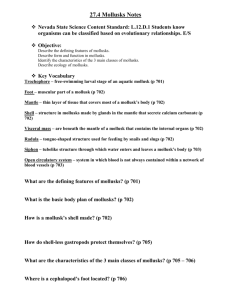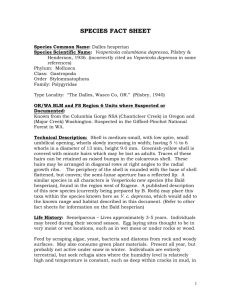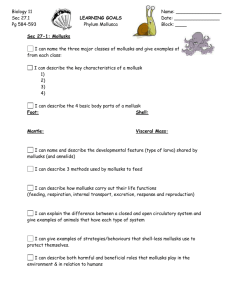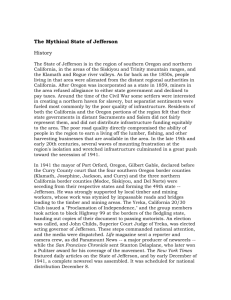Document 10555972
advertisement
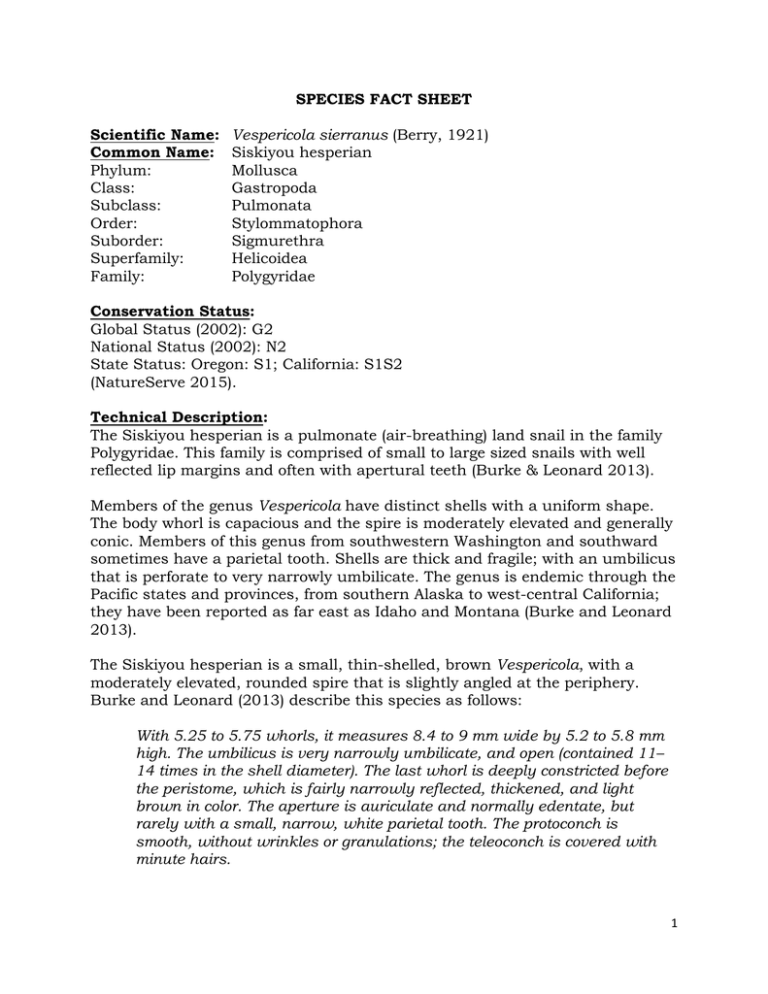
SPECIES FACT SHEET Scientific Name: Common Name: Phylum: Class: Subclass: Order: Suborder: Superfamily: Family: Vespericola sierranus (Berry, 1921) Siskiyou hesperian Mollusca Gastropoda Pulmonata Stylommatophora Sigmurethra Helicoidea Polygyridae Conservation Status: Global Status (2002): G2 National Status (2002): N2 State Status: Oregon: S1; California: S1S2 (NatureServe 2015). Technical Description: The Siskiyou hesperian is a pulmonate (air-breathing) land snail in the family Polygyridae. This family is comprised of small to large sized snails with well reflected lip margins and often with apertural teeth (Burke & Leonard 2013). Members of the genus Vespericola have distinct shells with a uniform shape. The body whorl is capacious and the spire is moderately elevated and generally conic. Members of this genus from southwestern Washington and southward sometimes have a parietal tooth. Shells are thick and fragile; with an umbilicus that is perforate to very narrowly umbilicate. The genus is endemic through the Pacific states and provinces, from southern Alaska to west-central California; they have been reported as far east as Idaho and Montana (Burke and Leonard 2013). The Siskiyou hesperian is a small, thin-shelled, brown Vespericola, with a moderately elevated, rounded spire that is slightly angled at the periphery. Burke and Leonard (2013) describe this species as follows: With 5.25 to 5.75 whorls, it measures 8.4 to 9 mm wide by 5.2 to 5.8 mm high. The umbilicus is very narrowly umbilicate, and open (contained 11– 14 times in the shell diameter). The last whorl is deeply constricted before the peristome, which is fairly narrowly reflected, thickened, and light brown in color. The aperture is auriculate and normally edentate, but rarely with a small, narrow, white parietal tooth. The protoconch is smooth, without wrinkles or granulations; the teleoconch is covered with minute hairs. 1 This species is smaller than other Vespericola and resembles Cryptomastix germana and Trilobopsis loricata species found in this region (Burke and Leonard 2013). This species is distinctly umbillicate and lacks additional apertural teeth (Pilsbry 1946). Life History: Little is known regarding the feeding habits, growth, reproduction, or life span of the Siskiyou hesperian. Vespericola snails, in general, feed by scraping algae, yeast, bacteria and diatoms from rock and woody surfaces, and may also consume green plant materials (Duncan 2009). Like other pulmonate snails, members of this genus are hermaphroditic, having a single male and female gonad organ and exchanging gametes with conspecific individuals when conditions are favorable (Duncan 2005). Eggs and sperm of pulmonate snails often develop at different times within the individual such that self-fertilization is uncommon (Nordsieck 2010). Once fertilized, the egg develops into a veliger larval stage, found inside of the egg. When the veliger matures, a fully formed juvenile snail emerges from the egg (Nordsieck 2010). The life span and reproduction of this taxon are probably similar to that of the closely related V. columbiana depressa, a species which lives approximately 3 to 5 years, reproduces only once in its lifetime (semelparous), and likely breeds during the second season, presumably laying eggs in very moist locations such as in wet moss or under rocks or wood (Duncan 2009). Vespericola c. depressa is entirely terrestrial, but seeks refugia sites where the humidity level is relatively high and temperature is constant, such as deep within cracks in mud, in rock talus or under permanently moist vegetation (Duncan 2009). This species may travel several hundred feet during a season, only to return to original refugia sites. Records of V. sierranus exist from March through December, although it may be present all year (Duncan 2009). Range, Distribution, and Abundance: The Siskiyou hesperian was originally found throughout southern Oregon, northern California, and northern Nevada at broadly scattered sites. Today it is found in northern California and southern Oregon (See Attachment 3). Distribution in Oregon includes sites as far north as Myrtle Creek, as far east as the Wood River Valley, and as far west as just north of Cave Junction (See Attachment 3). Forest Service/BLM lands: The Siskiyou hesperian has been documented on three National Forests (Fremont-Winema, Rogue River-Siskiyou, and Umpqua) and three BLM Districts (Medford, Roseburg, and the Klamath Falls Resource Area on Lakeview) in Oregon. 2 Habitat Associations: The Siskiyou hesperian is primarily a riparian associate found in perennially moist habitat, including spring seeps and deep leaf litter along streambanks and under debris and rocks. Moist valley, ravine, gorge, or talus sites are preferred, near the lower portions of slopes in areas that are not subject to regular flooding. It may occur in areas with running water or alongside streams and spring pools (Roth 1993; Frest & Johannes 1996). This species also may be found in marsh areas under woody debris (Burke and Leonard 2013). The Siskiyou hesperian has been found in association with other Vespericola species, Prophysaon, Oxyloma, and Deroceras (Frest and Johannes 1996). Threats: Because the Siskiyou Hesperian has a limited distribution and its habitat tolerances are unknown, any environmental alteration at known sites should be viewed as a possible threat. Mollusks are extremely sensitive to temperature and moisture extremes and changes (Jordan & Black 2012). Habitat loss and alteration are considered the most serious threat to this native mollusk. Recreational use of this species’ habitat may result in loss or degradation of habitat. Removal of forest overstory from logging can dry important subterranean refugia and result in a loss of aestivating individuals. Concentrated use of riparian areas by livestock may also degrade habitat, as can development for agriculture or human use (Frest & Johannes 2000). Conservation Considerations: Inventory: ● Survey for and map all Siskiyou hesperian occurrences. Management: ● Protect all new and known sites from practices that would adversely affect any aspect of this species’ life cycle, including timber harvest, cattlegrazing, road construction, building construction, and hydrologic modifications. ● Since land mollusks are small animals with limited mobility and dispersal capabilities, the maintenance of refugia in disturbed habitat is particularly important for this group. Refugia should include logs, snags, fallen branches, and other forms of coarse woody debris, as well as areas with thick leaf-litter. Woody debris and litter provide islands of habitat, food, and protection from microclimatic extremes, increasing species’ tolerance of temporarily inhospitable environments (Jordan & Black 2012). 3 • Research suggests that in order to reduce microclimate extremes and protect gastropods, partial cuts should be favored over clearcuts, aggregated (group) retention over dispersed retention or thinning, and larger group retention over smaller group retention. In particular, harvesting with large group retention helps to maintain pre-harvest boreal gastropod assemblages and will likely conserve boreal gastropod species if used as a tool for biodiversity management (Jordan & Black 2012). ● Numerous studies have found negative and long-lasting responses of gastropods to fire, including population extirpation and reductions in abundance and species richness (Jordan and Black 2012 and references therein). Small burns surrounded by unburned plots have been most successful at maintaining gastropod community structure. Although there is little information comparing gastropod responses to differences in burn severity and frequency, it is presumed that a fire regime involving low-intensity burns at infrequent fire-return intervals (>5 years) would best maintain gastropod communities (Jordan & Black 2012). ● Due to the tendency of mollusks to avoid non-vegetated and/or dry environments, even narrow, unpaved roads with low traffic densities are barriers to the dispersal of mollusks (Jordan & Black 2012). Prepared by: Rich Hatfield and Sarah Foltz Jordan, Xerces Society Date: March 2015 Edited by: Sarina Jepsen Date: March 2015 Some text adapted from previous version: Theresa Stone, Umpqua National Forest Date: 30 September 2009 ATTACHMENTS (1) (2) (3) (4) (5) References List of pertinent or knowledgeable contacts Map of Species Distribution Photographs of species Survey Protocol with species specific details 4 ATTACHMENT 1: References Applegarth, John. 2013. Wildlife biologist, BLM (retired), Springfield, Oregon. Personal communication and Wildlife Report datasheets shared with Sarah Foltz Jordan, Xerces Society. ANSP. (n.d.). Academy of Natural Science: MAL. Philadelphia, PA. Attwood, S. W., and E. S. Upatham. 2012. Observations on Neotricula aperta (Gastropoda: Pomatiopsidae) population densities in Thailand and central Laos: implications for the spread of Mekong schistosomiasis. Parasites & vectors 5:126. biomedcentral.com. Brown, K. M. 2001. Chapter 10: Mollusca: Gastropoda. in J. H. Thorp and A. P. Covich, editors. Ecology and classification of North American freshwater invertebrates, 2nd edition. Academic Press. Burch, J. B. 1982. Freshwater snails (Mollusca: Gastropoda) of North America. Environmental Monitoring and Support Laboratory, Office of Research and Development, US Environmental Protection Agency. Davis, G. M. 1967. Systematic relationship of Pomatiopsis lapidaria and Oncomelania hupensis formosana (Prosobranchia: hydrobiidae). Malacologia v.6:1–139. Davis, G.M. 1979. The origin and evolution of the gastropod family Pomatiopsidae, with emphasis on the Mekong River Triculinae. Academy of Natural Sciences of Philadelphia, Monograph 20: 1-120. Duncan, N. 2008. Former Forest Service and BLM mollusk taxa specialist. Personal communication with Sarah Foltz Jordan, The Xerces Society. Dundee, D. S. 1957. Aspects of the biology of Pomatiopsis lapidaria (Say)(Mollusca: Gastropoda: Prosobranchia). University of Michigan Museum of Zoology. Available from http://deepblue.lib.umich.edu/handle/2027.42/56344. Dunk, J. R., W. J. Zielinski, K. West, K. Schmidt, J. Baldwin, J. Perrochet, K. Schlick, and J. Ford. 2002. Distributions of rare mollusks relative to reserved lands in northern California. WSU Press. Available from https://research.libraries.wsu.edu/xmlui/handle/2376/932. Frest, T. J., and E. J. Johannes. 1996. Freshwater Mollusks of the Upper Klamath Lake Drainage, Oregon. Deixis Consulatants, Seattle, WA vii+ 200 pp. Report to the Oregon Natural Hertiage program and Klamath Lake Project, USDI Bureau of Reclamation. Frest, T. J., and E. J. Johannes. 2000. A baseline mollusk survey of Southwestern Oregon, with emphasis on the Rogue and Umpqua River drainages. Deixis Consultants, Seattle, Washington. Jepsen, S., C. Voight, and S. Foltz Jordan. 2011. Final Report to the Interagency Special Status / Sensitive Species Program regarding surveys for the marsh walker (Pomatiopsis chacei) in southwestern Oregon. Submitted to Interagency Special Status / Sensitive Species Program from the Xerces Society for Invertebrate Conservation. Johannes, E. J. 2015. Deixis Consultants and Mollusk expert. Personal Communication. 5 Jordan, S. F., and S. H. Black. 2012. Effects of Forest Land Management on Terrestrial Mollusks: A Literature Review. The Xerces Society for Invertebrate Conservation; With the Interagency Special Status and Sensitive Species Program USDA Forest Service, Region 6 and USDI Oregon/Washington Bureau of Land Management. Kameda, Y., and M. Kato. 2011. Terrestrial invasion of pomatiopsid gastropods in the heavy-snow region of the Japanese Archipelago. BMC evolutionary biology 11:118. biomedcentral.com. Natureserve. 2015. Comprehensive Report Species – Vespericola sierranus. Available from http://www.natureserve.org/explorer/ (accessed March 19, 2015). Schalie, H. van der, and D. S. Dundee. 1955. The Distribution, Ecology and Life History of Pomatiopsis cincinnatiensis (Lea), an Amphibious Operculate Snail. Transactions of the American Microscopical Society 74:119–133. Wiley on behalf of American Microscopical Society. Taylor. 1981. Freshwater mollusks of California: a distributional checklist. Tyron, G. W., Jr. 1862. Notes on American Fresh Water Shells, with Descriptions of Two New Species. Proceedings of the Academy of Natural Sciences of Philadelphia 14:451–452. Academy of Natural Sciences. Nordsieck, R. 2010. The reproduction of Gastropods. Available from http://www.molluscs.at/gastropoda/index.html?/gastropoda/morphology /reproduction.html (accessed March 24, 2015). Pilsbry, H. A. 1946. Land Mollusca of North America (north of Mexico). Volume 2. Academy of Natural Sciences of Philadelphia Monographs. Roth, B. 1993. Critical review of terrestrial mollusks associated with latesuccessional and old-growth forests in the range of the northern spotted owl. Prepared For: Forest Ecosystem Management Working Group, USDA Forest Service. Van der Schalie, H., and H. J. Walter. 1957. The Egg-Laying Habits of Pomatiopsis cincinnatiensis (Lea). Transactions of the American Microscopical Society 76:404–422. ATTACHMENT 2: List of pertinent or knowledgeable contacts Barry Roth, consultant Tom Burke, consultant 6 ATTACHMENT 3: Map of Species Distribution Map of site locations of the Siskiyou hesperian (Vespericola sierranus). The Xerces Society (2015). 7 Range map of Vespericola sierranus. Recreated from Burke and Leonard (2013). 8 ATTACHMENT 4. Photographs of species Shell of the Siskiyou hesperian (Vespericola sierranus). Scale bar is 1 cm. Photo © William P. Leonard (Burke and Leonard 2013), used with permission. ATTACHMENT 5: Survey Protocol with species specific details Taxonomic group: Gastropoda Please refer to the following documents for detailed mollusk survey methodology: 1. General collection and monitoring methods for aquatic and terrestrial mollusks (pages 64-71): Frest, T.J. and E.J. Johannes. 1995. Interior Columbia Basin mollusk species of special concern. Final report: Interior Columbia Basin Ecosystem Management Project, Walla Walla, WA. Contract #43-0E00-49112. 274 pp. plus appendices. 2. Pre-disturbance surveys for terrestrial mollusk species, the objective of which is to establish whether a specific mollusk is present in proposed project areas with a reasonable level of confidence, and to document known sites discovered during surveys: Duncan, N., Burke, T., Dowlan, S. and P. Hohenlohe. 2003. Survey protocol for survey and manage terrestrial mollusk species from the Northwest Forest Plan. Version 3.0. U.S. Department of Interior, Bureau of Land Management, Oregon/Washington and U.S. Department of Agriculture, Forest Service, Region 6, U.S. Fish and Wildlife Service. 70 pp. Available at: http://www.blm.gov/or/plans/surveyandmanage/files/11mollusks_v3_enclosed2.pdf (Accessed 25 March, 2015). 9 3. Inventory report including standard data forms for terrestrial mollusk site surveys: Hendricks, P. and B. A. Maxell. 2005. USFS Northern Region 2005 land mollusk inventory: a progress report. Report submitted to the U.S. Forest Service Region 1. Montana Natural Heritage Program (Agreement #05CS-11015600-033, Helena, Montana. 52 pp. Available at: http://www.fs.usda.gov/Internet/FSE_DOCUMENTS/stelprdb5130938. pdf (Accessed 25 March, 2015). Species-specific Survey Details: Vespericola sierranus Where: This species can be found in appropriate habitat in southern Oregon, from Roseburg south to the state border, east of Cave Junction and west of Klamath Falls. Habitat: Throughout its range in southern Oregon, this species can be found in perennially moist habitat, including spring seeps and deep leaf litter along stream banks and under debris and rocks. Moist valley, ravine, gorge, or talus sites are preferred, near the lower portions of slopes in areas that are not subject to regular flooding. It may occur in areas with running water or alongside streams and spring pools (Frest and Johannes 1996, Roth 1993). This species also may be found in marsh areas under woody debris (Burke and Leonard 2013). When: Like other terrestrial snails in the region, this species is probably best surveyed during spring and fall, when the weather is most suitable (cool and moist) for finding active snails and slugs. This species can also likely be found in summer during bouts of humid rainy weather. Known records of live Siskiyou hesperian snails are from March through November. A general Forest Service survey protocol for terrestrial land snails recommends surveys be conducted only at temperatures greater than 5 °C and when the soil is moist to the touch (Dunk et al. 2002). How: Hand collection in the appropriate habitat is probably the best survey method for the Siskiyou hesperian. Logs, woody debris, building materials, and other objects should be turned over and examined for this taxon (Applegarth 2013, pers. comm.). 10 The following methodology has been used during surveys for other rare (ISSSSP sensitive/strategic) terrestrial snails in Oregon and Washington in recent years (Jepsen et al. 2011, 2012): ● Survey areas were visited in April to May, after spring melt-out, or from September to November, as fall‐winter rains occur, but before the first heavy freeze. ● While driving or hiking in a selected area, key habitat features known to be utilized by the target species (e.g., talus slopes, basalt outcrops, seeps on rock walls) were searched for. ● Promising areas were surveyed by turning over and examining the undersides of rocks and/or dead wood. Vegetation was also examined. Hand rakes were used for moving talus and to aid in searching. Hand lenses aided identification in the field. A GPS unit recorded geographic coordinates for each site surveyed. ● A minimum of 20 minutes search time was spent at each site, although the total time spent at each site varied based on findings. If 20 to 30 minutes were spent searching for mollusks without finding additional species during that time period, surveyors moved on to a new site. ● When mollusks were observed, voucher specimens (shells and live snails) were collected in small vials or recycled yogurt containers and kept in a cooler with ice. In the evening, small snails were placed directly in 70% ethanol, whereas large snails were drowned overnight in water (causing them to emerge from their shells) and then stored in 70% ethanol. Note, however, that Jepsen et al. (2012) found that the overnight drowning period for was not adequate for large snails, and it is recommended that large bodied snails (such as Vespericola) collected in future surveys should be left in water for at least 24 hours before storing in ethanol. This is important in enabling examination of the soft tissues of these specimens for identification purposes (Jepsen et al. 2012). Identification of this taxon is based on external shell morphology and internal features, as outlined in the fact sheet. Expert identification is recommended. 11


